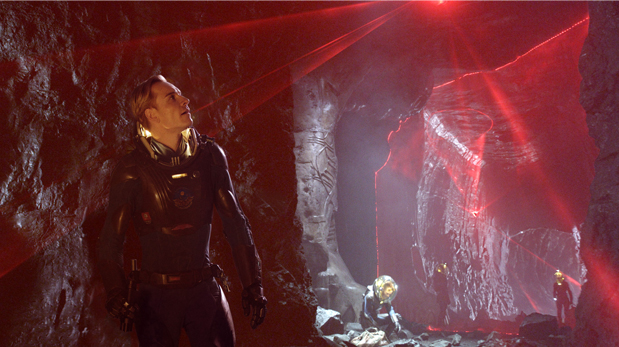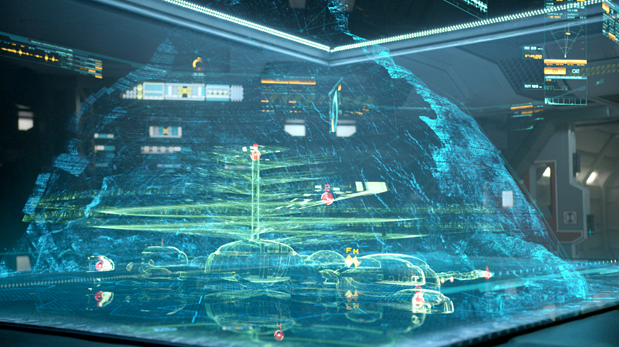This past Friday the ST8MNT team took a short break from our normal schedule to go see Ridley Scott’s latest installment in the Alien series, Prometheus. In the film, a small crew lead by archeologists Elizabeth Shaw (Noomi Rapace) and Charlie Holloway (Logan Marshall-Green) visit the far off planet LV-223, after repeatedly finding a star map in several unconnected ancient cultures and taking it to be an invitation. What follows next, as you can tell by the trailer, is that the crew realizes that traveling several light years from earth may not have been one of their best decisions.
After seeing this movie I’ve learned very quickly that Mr. Scott is a master of symbolism in film. There have been hundreds of blog posts written seeking to break down every allegory presented in the movie; which is fair because there is an overwhelming amount of symbolism which does seem necessary considering the movie plot, at its core, is about the search for a creator. But this blog post is not really about that. (If thats what you are looking for this is a pretty great writeup)
The most impressive aspect of Prometheus is the prediction and portrayal of technology in the film. The movie is set over a short span of time but mainly takes place in 2092 which is really only about 80 years from now. Most movies, even those set in current time, show an idealized view of technology that we are nowhere near. Whereas this is one of the areas that makes Prometheus more “believable”. In 80 years it’s completely possible that we will have robots that are indistinguishable from humans and are really artificial intelligence. The technology for this already exists, in fact a significant part of the global population are carrying it around in their pockets right now. What I’m referring to is Apple’s iPhone 4s and Siri. What Siri does that stands out in contrast from other modern mechanical robots is that the goal of Siri is to be able to learn and predict what you, the user, want. Norman Winarsky, vice president of SRI Ventures and co-founder and board member of Siri, has a great interview with Robert Siegel on NPR where he talks about the creation on Siri.
WINARSKY: On television. Do you remember Radar O’Reilly in “MASH”?
SIEGEL: Of course.
WINARSKY: Well, Radar O’Reilly always knew what the captain wanted before the captain knew what the captain wanted. That was the inspiration for CALO [cognitive assistants that learns and organizes]. We wanted to assist people in their everyday life. We wanted to provide them a virtual personal assistant that could help them in their meetings, help them with what they want to accomplish, help them look forward in making their reservations. This was inspired originally by that, in fact.
SIEGEL: So you think that if I had a virtual personal assistant for a few years, that my virtual personal assistant – by virtue of what it knows and what questions of mine it’s familiar with – would be significantly different from my friend’s virtual personal assistant who has another iPhone, and uses the same program?
WINARSKY: So there is that capacity that was always in the original vision of Siri that it can be personalized to you and learn from you and your preferences and your favorites. And, yes, it does have some of that now, but you can be absolutely sure that it will continue to do that in the future. — via NPR
The interesting thing about Siri is that the technology was so quickly and widely accepted. The more that AI technology is developed the more it will become normalized in our culture providing a gateway for a humanoid AI to exist. Even objects such as the geographical mapping “pups” don’t seem like their that far off into the future. Maybe floating-scanning-shperes are a bit of a stretch but the thing thats impressive here is the way that the data they are transmitting back is presented. There is not a super detailed hologram showing every nook and detail of the caves but rather a sort of sketch of the area that seems to be pretty close in line with the current hologram technology that is being developed. There’s a great article on the current (as of 2010) state of hologram development from The New York Times that sounds just as sci-fi as the technology in Prometheus looks.
At the University of Arizona in Tucson, Dr. Peyghambarian created his displays using 16 cameras. Software rendered the images in holographic pixels, and laser beams directed by the software recorded the information on a novel plastic that can be erased and rewritten in two seconds. Dr. Peyghambarian says that the group is working on speeding up the rate and expects versions to be in homes in 7 to 10 years. Slower versions may be useful far sooner, for example, for long-distance medical consultation. — via The New York Times
The application of hologram technology has the potential to be endless, I mean, it allowed Tupac to preform at Coachella this year right? (actually that wasn’t a hologram) Regardless Prometheus sported technology that we may never have such as the ability to travel at the speed of light and hypersleep. As promotion for the movie, Weyland Industries set up a website with information about the “company”. The most interesting part of the site is the timeline which essentially shows the history of Peter Weyland as a pioneer in the technological world. The fictional progression is interesting, having Peter born in 1990 and global warming being reversed (by him) by 2016 and so on, is a very idealized view on our technological capabilities. What is not idealized here is the idea that reversing global warming is something that could be accomplished. The most impressive aspect of technology is its potential to grow exponentially (aka Moore’s Law) which we are already seeing in the world today. but the important thing to realize here is that regardless of technological advancements we are breeding a culture of technological assimilation. Understanding this culture and being able to predict how we will grow inside of, and react to technology is what makes Prometheus so successful. I really appreciate the vision that in 80 years we could live in a society that is marginally better than our own and holds the promise to keep growing. I think journalist Adam Frank sums it up best;
[…] the invention of a new technology is often not the most important part of the story. It is only when a technology becomes assimilated, only when its scientific and engineering principles become the raw material for culture building that new and unforeseen futures become possible. — via NPR
So in short go see Prometheus. When it’s finished you’ll leave the theatre with a head full of questions, just make sure one of them is “How will I affect the future of technology?”




